Diem Burden's Blog
May 20, 2024
Viana to Burgos (all you need to know)
Part II in my series of GET UP & WALK is now available via Amazon for just €2.00. Packed full of history and other useful tips so that you can get the most out of your walk along the Camino de Santiago.
You should read it before you walk this section, or you'll regret you hadn't later!

I'm currently updating part I of the series (SJPdP to Viana) with more history and information to better reflect book II.
August 25, 2023
Need more vegetables in Spain? Try Gazpacho!
Many people worry about the lack of vegetables provided with typical Spanish meals, and it can be a shock to the system for some people. In many cultures, veg comes on the plate with the main meal.
A typical set meal in Spain is 3 courses, and the vegetables usually come in the first course. The second (main course) might be a steak with chips/fries, and a dressing of side pepper (and no other vegetables). If, like me, you just order a main course meal off the menu (such as a steak), you may well lack your daily consumption of vegetables.

So here is a possible solution to help you top up on those all-important vegetables.
Gazpacho.This is a traditional Spanish dish which is similar to soup, only it is served chilled, which is ideal in the hot Spanish sun. It is highly refreshing, nutritious and delicious. Typical ingredients include tomato, peppers, cucumber, onion, garlic and lemon, along with olive oil and vinegar, and of course, salt.

Available in most cafes and bars in Spain, as well as from all supermarkets and stores. It makes an ideal light (and cheap) lunch, and goes well with some delicious Spanish bread. Seriously, it is hard to find a bad Gazpacho!
[image error][image error][image error]Gazpacho and bread – my go to Spanish lunch throughout the hot Spanish summer!
August 14, 2023
Book trailer – Get up and Walk
My first attempt at a book trailer using iMovie. I think it shows well what walking the camino is truly like.
https://youtu.be/6lCIDVHchGYJuly 17, 2023
Get Up and Walk
Free ebook about the Camino de Santiago (Camino Frances)!
Now available to pre-order on all platforms.
Having previously walked along the Camino de Santiago from Saint Jean Pied de Port to Roncesvalles as a lifelong, uncompromising atheist, Diem returns to Roncesvalles to walk for another week, this time across Navarra to his hometown of Viana.
But instead of walking as an ardent atheist, now he is walking hand in hand with God.
A 'Road to Damascus' type event had completed transformed Diem's life months earlier. Now, with over half a century of bad atheist ways to overcome, he sets himself an action plan for each week he intends to walk.
Week one (Saint Jean de Pied Port to Viana): Letting Him lead.
Diem intends to do no planning whatsoever, and to put all his faith in God's provision.
Does he succeed?
Click the cover to get your free copy!
Part one of a five-book series of week-long walks along the entire Camino Francés in Spain, each with a different action plan with God.
**Coming soon: Viana to Burgos - Praying over people.**
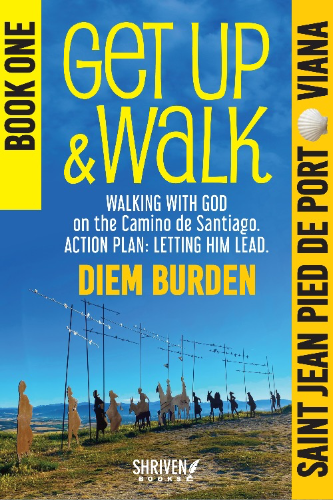
July 15, 2023
Ruins of San Pedro church, Viana
In Viana (Navarra) is the ruin of the 13th century San Pedro church, which is free to enter. Sadly, the majority of pilgrims refuel in Viana, then simply walk past the main entrance to the church without even looking in!
The church was the first to be built in Viana and was an integral part of the defensive structure of the city. It was much taller than the current church in the main plaza! Arrow slits can still be seen in the walls of San Pedro.
It contains some original ceiling painting, but more interestingly, a closer look will reveal a variety of stonemason 'signatures'. When these buildings were constructed, many stone cutting teams were used, and to ensure they got paid for their work, they marked each of their stones with the stonemasons 'signature'. As this was before most people could write, it comprised a distinctive mark. It's a great activity for kids to see how many different signatures they can spot. They are clearly visible near to the painted ceiling area. Most people nowadays mistakenly dismiss this as graffiti.
The church is available to rent for parties, weddings, etc, and the cupola makes for some great acoustics if any pilgrim is musical. It is also a great place to get out of the heat and chill, as the big old walls stay cool during the hottest days. If you are staying at the municipal albergue alongside the church, you may get to see a free concert from your window!
Passing through the church, exit into the mediaeval alleyway alongside the municipal albergue, and you can enter the gardens to the rear (formerly the cemetery). Blessed with gentle elevator music, this garden is also a great spot to chill and eat a packed lunch, and a great place to watch the sunset. The nearby bar will sell you a drink to go (para llevar) to take to the garden.
The views across the Ebro Valley to Logroño are spectacular, and you can spot the camino as it winds its way across to that city.
[image error][image error][image error][image error][image error][image error][image error][image error][image error][image error][image error][image error][image error][image error][image error][image error][image error][image error][image error][image error][image error][image error][image error]The wallsIf you (carefully!) look over the edge, you will see the great walls of the old fortified Viana. Viana was the frontier town between the ancient kingdom of Navarra and Castilla, who was the enemy. The Ebro river in Logroño was the de facto border between the two kingdoms, and this spot was ideal for seeing the enemy advancing. To see the walls from below, follow the camino of the old centre, and as you pass through the gate, you will come across an end house which is weirdly round in shape. This is because it was a defensive tower protecting that gateway (see the old plan of the village in photos). Turn left at the roundhouse and walk for 150m and you will be at the foot of the walls.
The church was bombed and damaged in during the Carlista wars in the early 1800s. In 1844, after some poorly done extension work, the church collapsed.
Buen camino!
July 8, 2023
Free police SOS app for Spain
ALERTCOPS is an authorised app issued in Spain. It is free to download and use, and is available in English. It is an ideal app for pilgrims on the Camino de Santiago.
It permits you to send an instant report of crimes/incidents to the police, with photos and video if necessary, and your location.
Once downloaded, you should spend some time configuring it. It is a little unclear in places.
If you select to give it access to your GPS (recommended), it can send a report straight to the emergency services with your precise location. It can also send push notifications to your phone if there are threats in your vicinity.
Go to >More (bottom right)>Geolocalised Services> and choose the frequency of checks.
You can add up to 3 'guardians' who can receive a message and audio from you if you activate the SOS function. Instructions via the 'more' page, under SOS.
Once set up, there is a test button to see if it is functioning.


July 3, 2023
The Alto de Perdón - Legends and History on the Hill of Forgiveness, Navarra.
At 1pm, I was glad to reach the tiny village of Zariquiegui for several reasons. First, I was starving and thirsty, and I knew that there was a café and a shop there. Second, I knew that the peak of the day’s ascent, the big hill called the Alto de Perdón, was just two kilometres further on from the village, and I wanted to rest and restore my energy levels before the arduous climb.
I sat in the shade of the street outside, along with half a dozen other pilgrims all doing the same. I had a large sandwich from the local bar, along with an energy drink, and sat mostly in silence, as I didn’t feel capable of making small talk with strangers.
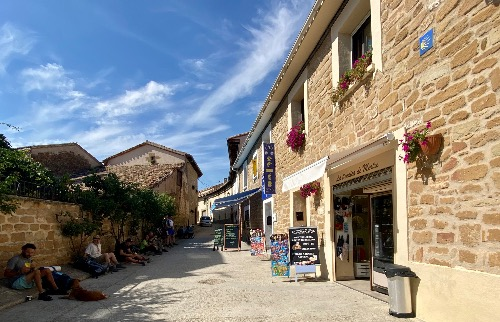
As I delighted in the cold drink, I was amazed to see Tommaso, the injured Italian guy, hobbling towards me. He saw me and I jumped up, and we hugged like old friends. He showed me a knee brace he was wearing, but he still didn’t have a pair of walking poles with him. I was extremely pleased to know that he was okay, and had received some treatment for his knee, yet incredulous to see him still struggling on with his camino. I later learned that he was a nurse, and knew how to deal with his own injuries. I didn’t know if he had walked all the way, or perhaps had stopped for a day in Pamplona, then jumped ahead by taxi or bus. I advise him of the hill up ahead, and watched in admiration as he walked off along the street, determined to get up and over the Alto de Perdón.
After about forty minutes of total rest and preparation, I set off again, aware that the Alto stood between me and the next village, Uterga, 6km away. I soon caught up with Tommaso as he was slowly struggling up the ascent, and I briefly offered him my poles again, knowing full well that he would refuse. He smiled, shook his head, and patted me on the shoulder. I shook my head in frustration and admiration, and carried on up the hill.
Fuente ReniegaApproximately 100m before the summit, I came across a circular stone water font, with water running into a basin. Many pilgrims simply walk on by, but the font has an incredible camino legend attached to it. Now called the Gambellacos Font, the original name was the Fuente Reniega (Font of the Denier - from the verb ‘to deny’).
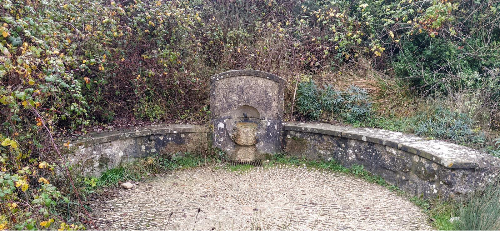
In times of old, during a particularly hot summer, a tired and thirsty pilgrim was approached at this spot by a handsome young man who was actually the devil in disguise. The man offered the pilgrim the possibility of refreshment and a drink, if he just denied God. The pilgrim’s faith was strong, so he rejected the offer. The man then offered him the same if he just rejected the Virgin Mary. Once more, the pilgrim refused the offer. The man persisted, and this time offering the refreshment if he would just deny the Apostle James (Santiago). The pilgrim once more refused, and began to pray to God for help. Immediately, the man disappeared in a cloud of sulphur, and in his place appeared the fountain. The thirsty pilgrim drank from the font using his scallop shell.
I walked on by and reached the summit. I removed my backpack and rested at the top, taking in the amazing sights. It was the fourth time I’d been there, and the views were always captivating. To the north is Pamplona, with the Pyrenees stretched out beyond. The walk had been all uphill from that distant city, and very uphill for the last few kilometres.
To the south are views over the farmlands of the Valdizarbe valley, with its medieval villages and fields of crops, along with occasional glimpses of the camino as it winds its way down through the rich tapestry of the ancient Kingdom of Navarra.
The high and open spot is always very windy, and, for this reason, it was the first location to have wind farms installed in Navarra, with forty wind-turbines in total, each at 40m high.
Although these turbines dominate the hill, most people come to see the 'Monument to the Pilgrim'. This life-sized, sheet-metal sculpture of a caravan of pilgrims through the ages is a must-see monument1 on the camino, and one of the most famous.
Monument to the Pilgrim
It represents the evolution of the way through history, with 14 figures walking, on donkey or on horseback. A closer look at the individual pilgrims reveals how they have changed over the years, and an inscription on one of the horses reads, ‘Donde se cruz el camino del viento con el de las estrellas.’ (Where the path of the wind crosses with that of the stars.) Above the pilgrims are the stars of the Milky Way, which used to guide them. Sadly, most pilgrims simply pose for a photo with it and walk on.
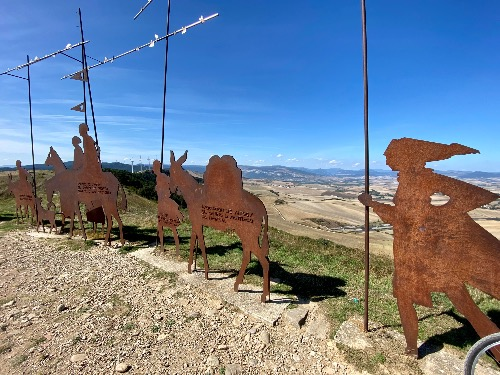 Hermitage and Hospital Ruins
Hermitage and Hospital RuinsAdjacent to the magnificent sculptures are the remains of a 13th century hermitage, which used to have great importance on the camino. Any pilgrim that reached the hermitage on top of the hill would have their sins forgiven, and their spiritual health was guaranteed in case of their death before reaching Santiago. These days, pilgrims mostly aren’t aware of any of this, and just use the foundations as a bench for their backpacks whilst they take in the surrounding views. The hermitage was plundered by French troops during the War of Independence and eventually disappeared.
Attached to the hermitage was a hospital for pilgrims, and nearby was a henge-like memorial to the local people murdered in Spain’s civil war. It stands off to one side, like an irrelevant and uncomfortable memory.
Some pilgrims spot the nearby signpost, indicating such distances as Berlin 1,600km, and NewYork 5,800 km.
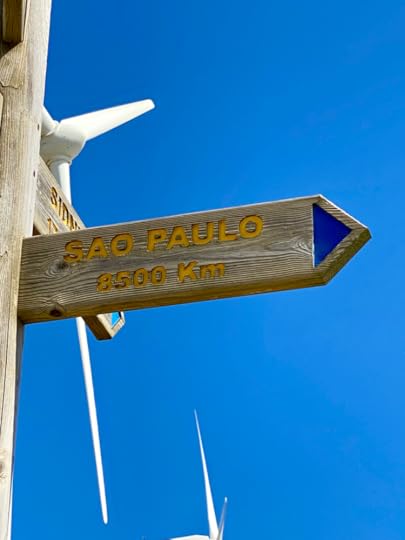
Just as I put my backpack on, I saw Tommaso reaching the summit. I congratulated him, patted him on the back, and walked on.
The DescentThen came the dreadful descent. As expected, it was truly awful. It is possibly the most treacherous of descents on the camino, and not one for cyclists to do! There is an alternative route for cyclists signposted, one that people can also take.
Extremely steep for about 1km, a rubble and boulder-strewn trail runs down the side of the hill. Fortunately, it was dry — I’d hate to do it in the wet! It is a trip hazard, easy to fall, and rather isolated. I remembered the last time I’d descended that hill — it was on my mountain bike when I was a support vehicle, and my friend was shocked when she’d seen me ride over the edge and descend. It was so difficult to navigate on my bike that my cylinder brakes burnt out by the time I reached the bottom, and I had to ride to Villamayor with just the front brakes!
My toes were in agony, and I truly felt for Tommaso and his knee. So many people had suffered on this section, and I was no exception!
I eventually felt the slope flattening out, and the boulders began to reduce in size, often leaving sheets of small stones which threatened to move under foot. I’d never been more thankful for having walking poles than I did that day. I was so glad to make it to the bottom without incident, although the sun was beating down on me. I’d put plenty of sunscreen on at each of my stops, but I really wanted to get to my destination and hide from it.
**Adapted from the book, Get up and Walk, a free ebook of my walk on the Camino de Santiago through Navarra, hand in hand with God. Coming soon!**

June 30, 2023
Lightening your load on the Camino de Santiago
At the end of that first day, when you stagger into your first stop, after that long and difficlut, walk over the Pyrennes, hungry, hurting and relieved, you feel every burden on your back and shoulders, relentlessly cutting into you, holding you down, pressing you into the earth. Surely you're not going to make it...?
Then, miracoulsly, as the days pass by, your load gets lighter. The weight holding you down is slowly cast aside with each step, with each smile, with each hug, with each adult stranger who opens their heart to you, with that skipping baby cow in the field, with the beauty of that landscape, with that food, that little church, with those pilgrims in the bar last night, with that local person who gave me a bed when there were no beds available, with that person who prayed over me, with that passing local who gave me a bottle of water for free in the midday heat, that free footbath, with that trestle table full of free food and drink, left there by an old man simply because he can, by that guitarist sitting under that tree, that bible verse etched into a rock with the words you needed to hear at that time, that stranger helping you put your backpack on, that person who hugged you when you cried, that stranger who gave you those words of encouragement just when you were ready to quit, those children playing in that plaza last night without a care in the world, still undamaged by life, that kitten, that sense of God on the camino, that memorial to that fallen pilgrim, that nun with that wicked sense of humour, that silence, that laughter, that love, that camino ...

When you arrive at your final destination, most of the guilt your have been carrying along the camino, that shame, that pain, that heartache, that trauma, that unforgiveness, those fears, that loneliness, those crisises, that loss, that grief, that anger, those frustrations, all of those scars of a life lived, all of those wounds, all having been opened to the fresh air of the camino, have healed, and have been left behind on the camino, and you are so so much lighter now.
You have survived...
But maybe you still carry something, something so deep and persistent that you were unable to leave it behind on your pilgrimage? Yet you know now that you are so much stronger than you were at the beginning, you are so different now. You know now that you can carry that burden, you are strong enough to face it down now. In fact, it is what made you who you are today. It is what brought you to the camino in the first place, and it is an integral part of who you are.
You are a survivor...
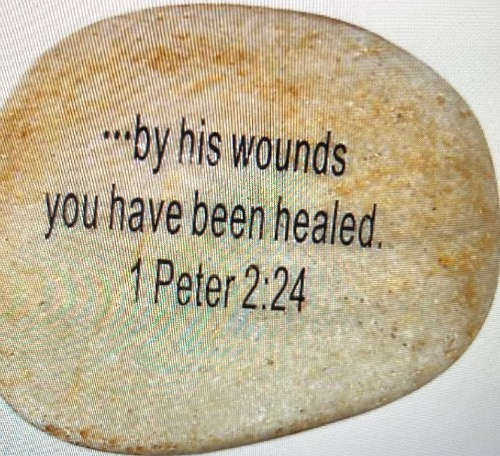
Far from letting this thing continue to define and confine you, you are now ready to face it, to deal with it. You are ready to wear it like a badge of honour, a medal of strength and courage, that thing so deep and dark and traumatic. You now have the strength to walk with your head held high once again.
You are a survivor. You are a pilgrim.
You have the strength to take it back home with you, because you are different now. You are ready to use that scar to help others overcome and survive their scars, just as you have survived, against the all the odds.
You are so much stonger than you know.
You are loved.
You are that survivor.
Your true camino has only just begun.
Buen camino, pilgrim.
June 7, 2023
Walking Poles - are they beneficial?
Walking poles - or trekking poles - are those long, pointy things people sometimes use when
walking long distances or over rugged terrain, especially seen on the Camino de Santiago, among other places.
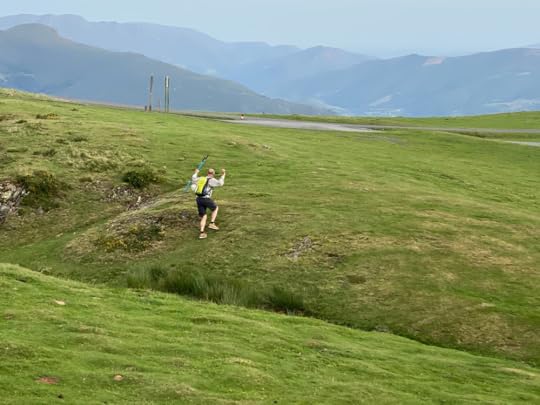
When I came to live in Viana, Navarra, many years ago, I saw many pilgrims walking through my adopted Spanish village with a pole in each hand. I had no idea what they were or why they were using them. As an ex-military guy, I'd done some pretty gruelling marches and was never given a set of these walking poles, so I guessed it was just some kind of fad, or a thing pilgrims do to show they are truly pilgrims, like carrying a shell on their backpack.
So in 2021, I did a two-day walk over the Pyrenees, from Saint Jean Pied-de-Port to Roncesvalles, which many pilgrims had told me was a tough walk. I wanted to know more about walking poles, so I did a lot of research, and took a set along with me to see if they were of any benefit to a walker.
The answer is a definite YES.
Reduction of stress on legsOne of the major benefits of using such poles is that they transfer some of your weight up onto your arms and upper body, thus relieving the stress on your legs. Walking hundreds of kilometers with weight on your back puts a tremendous amount of stress on your leg muscles, feet, and especially your knees. (Approximately 30% of the population suffers from knee problems, as they are the least developed part of the human body. The rest of the human body is growing bigger and heavier with each generation, but the knees still think it is the 1300s....!)
They also help reduce the potential for blisters, or help you if you develop blisters by allowing you to transfer weight from your painful feet to your arms.
They are also useful to help push you up out of your seat when standing up with weight on your back, seriously reduces the fulcrum effect on your knees.
In a nutshell, using trekking poles seriously reduces the stress on your legs, and therefore, they reduce the potential for injury.
 Whole body workout
Whole body workoutThe legs are the main workers when walking long distance, obviously. At the end of the camino, you'll have legs like an Olympic athlete, so enjoy the moment and wear shorts when you get back home, whatever the weather!
So wouldn't it be nice if you could actually exercise more than just your legs? Imagine having a whole body to show off! With trekking poles, you can! By transferring weight up through the arms, not only do they get a continuous workout, but so do your shoulders and back. You will be so much fitter all-over at the end of your pilgrimage!
Less fatigue at the end of the dayBecause you are spreading the pain, you won't collapse on your bed crying when you get to your accommodation each night. You'll actually feel much better than without poles, and might even have enough energy to explore the town you are staying in!
Reduces the risk of trips and fallsTrekking poles offer so much more support for the walker, particularly over rough terrain (or in the wet). You can use them to push you uphill, and when descending you put them out in front, spread apart, and use them as a kind of brake, as well as extra grip.
Self-defenceTrekking poles have a nasty pointy tip at the end, and could, if needed, be used for protection from stray dogs (or other unwelcome creatures!). Some people often hold them horizontally when fast cyclist are approaching to create a safety gap between the cyclist and the walker.
THINGS TO CONSIDER WHEN USING POLES There is a correct way to use them, so learn to use them properly. Particularly important is how you put your hands in the straps because if you do it wrong, and do fall, you can break your thumb! YouTube has many videos on how to, and benefits of, trekking poles. Here are two that are quite useful: https://youtu.be/Dp4ZvpP8Eq4 https://youtu.be/srw2HYVCAO8 If you are flying with poles, they might not be allowed in cabin bags, as they have a pointy end. Check them in! (On routes like the Camino de Santiago, there are numerous places to buy/replace your trekking poles.) They are extremely easy to lose! When you stop, exhausted, for a coffee, it is so easy to stand them against a wall, drop your pack and collapse. Once energised, you throw your pack on and march off, only to realise, after a few miles down the road, that something is missing, and have to go back to get your poles. Put them on top of your pack when you rest awhile! The ends are metal tips, and when used in towns and villages, the constant clack-clack sound is a real annoyance for residents. Be considerate, and only use them in the countryside. If you do have to use them in built-up areas (due to injury etc), ensure the metal tips have a plastic cap over them. Most poles come with caps provided, but are easily lost, or wear out.Are they essential? No, but highly recommended. Don't be like the pilgrim I met who, two weeks into his walk, developed a serious knee issue but absolutely refused to even consider using trekking poles.
Some manage without them, some use just a single pole. My advice is to experiment beforehand to see what suits you best, do your research, and make a decision.
I'm a fit, mid-50s guy, and whenever I walk the camino with weight on my back, I always use two poles, for all the reasons mentioned above. And yes, I did forget mine in a cafe once, and only realised when 3km down the road...
May 11, 2023
Wild camping in Spain - legal or not?
Why the complications? Let me explain...
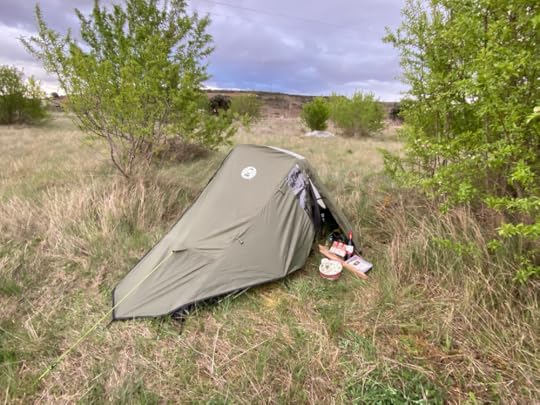
Spain comprises 17 autonomous communities, along with two autonomous cities (Madrid and Valencia). What this means is that much of the power is devolved down to the local level, and therefore laws are made at the local level. So, if you wanted to walk a Pitbull across Spain and wanted to know if it was classified as a dangerous dog, for example, and what rules applied to it, you would have to check the laws for each region you planned on walking through!
What about wild camping, though?Each region has very different laws.
If you are considering walking any of the caminos, and want to know if it is legal to camp, you need to check the laws for the particular regions you are walking through. For example, if you are walking the camino frances (the French Way), you'll need to check the laws for each of the following: Navarra, La Rioja, Castilla y Leon, and finally Galicia.
To make it easier for you, I have listed each of the regions below and the laws regarding wild camping. This information has been taken from a webpage called Jurides, which is a Spanish firm of lawyers, written in Spanish, but translated into English here. Please note that I accept no liability for any inaccuracies in this post, either legally or in translation. If you have any doubt of the legalities of what you are proposing, consult a lawyer (see disclaimer below).
Different types of 'camping'There is an infinite variety of different types of camping, but we will focus on four of them, as they are the most common.
CAMPING*: Human activity that consists of temporarily placing a dwelling (such as a tent or caravan), whether portable of improvised, in a place in order to inhabit it. PERNOCTAR*: Spending the night in a certain place, especially outside one's home, in a shelter or structure (often considered dusk till dawn camping). BIVOUAC: Spending the night in the open, without any structure to protect yourself, being able to use a sleeping bag or mat. TOURISM CAMPING: Public tourist establishments that are duly delimited and conditioned to live in the open air (public and regulated).*The principal difference between camping and pernoctar would be the purpose: spending the night (dusk to dawn) instead of living temporarily (staying beyond dusk to dawn).
REGULATIONSNational level Order of July 28, 1966.
Often used to indicate the legality of camping in Spain, but this law has been REPEALLED.
To clarify, we need to go back to the 1978 Constitution and the transfer of powers to the Autonomous Communities in relation to tourism. Each territory had to regulate and implement all European regulations in this regard, which, in 2010, was considered to have been fulfilled, and ALL STATE REGULATIONS ON THIS MATTER WERE THUS REPEALLED.
*FOR THIS REASON THERE IS NO NATIONAL STANDARD THAT REGULATES FREE CAMPING*
LAWS FOR CAMPING AT REGIONAL LEVEL ANDALUCIAVery restrictive legislation. Article 1, Decree 26/2018, generally prohibits camping and overnight stays for leisure or vacation purposes outside of official campsites. Violation is penalised via Tourism Law 13/2011, which means they cannot levy a fine, but they can force you to move on.
ARAGONArticle 14 of Decree 61/2006 prohibits free camping THROUGHOUT the autonomous territory. Legislative Decree 1/2016 of Tourism Law considers free camping a serious offence, with fines from €600 to €6,000!
ASTURIASAccording to Law 7/2001, any type of free camping is prohibited. A minor offence, with fines from €60.10 to €600.01.
BASQUE COUNTRYLaw 13/2016 regulates free camping, which generally prohibits it. It does not consider overnight stays in a motorhome in urban areas as free camping. In non-urban areas, it is the Town Hall that decides.
CANTABRIADecree 95/2002 prohibits free camping outside of tourist camps for more than 24hrs. Tents, etc. may be set up under the following conditions:
Maximum 3 structures No closer than 500m to urban centres No closer than 1km to a public campsite No closer than 100m to rivers or roads Carvans and motorhomes and the like are not permitted except in official campsites CASTILLA Y LEONOrder FYM/510/2013 prohibits all free camping outside of authorised campsites.
CASTILLA LA MANCHAThis Autonomous Community is one of the most regulated on this issue. Decree 63/2006 generally prohibits free camping in the following places:
Protected Areas, Hunting Reserves, Forests of Public Utility or others owned by the Board, forests subject to an agreement or forestry consortium, Protective Forests and on Livestock Routes that border forest lands. These limitations do not apply to the bivouac. In Protected Areas, the specific regulation will apply. In the case of free camping in a cross-country regime, the Ministry may authorize it on the land listed for free camping. In these cases, only a maximum of 10 people can spend the night. This authorization may also be requested by anyone with a minimum notice of 30 days. Within a maximum period of 15 days, it will be resolved. Otherwise, it will be understood as accepted by administrative silence, except in the case of Protected Areas. The creation of tourism camps and controlled camping areas is foreseen. They will be marked on the ground and the regulations will be published by each Provincial Delegation. In any case, in one of these areas, the maximum duration of stay will be 6 consecutive days. The installation of caravans is limited to areas with road access. CATALUNYA Catalonia regulates through Decree 55/1982 the requirements for the exercise of free camping: Groups of maximum 4 structures with a minimum separation between them of 250 meters. Maximum stay of 4 days. More than 1km from population centers, crowded places or (public) campsites. More than 100 meters from the road. In addition, Decree 148/1992 establishes the need for prior authorization to camp in natural spaces, in national hunting reserves, and in controlled hunting areas. EXTREMADURA Like Castilla La Mancha, Extremadura is another of the communities that has regulated this matter in detail. Law 2/2011, modified by Law 8/2011, distinguishes between: Tourism camps. Publicly owned camping areas. Provisional camping for events. Other modalities: free camping. Free camping would be found in this group, pending regulatory regulation.In fact, Decree 170/1999 prohibits free camping throughout Extremadura.
GALICIADecree 159/2019 prohibits all free camping outside of official campsites.
LA RIOJADecree 14/2011 prohibits camping throughout the region. Also holds any landowner who gave permission as culpable (yes, it is even illegal to camp on private property!)
MADRIDMadrid follows the same line as La Rioja: it expressly prohibits free camping throughout its territory. Although in the case of Madrid, Decree 3/1993 includes a caveat. Camping may be practiced outside the tourism camps when they are organized by a public or private entity for cultural, sporting or ecological purposes. Of course, as long as the stay does not exceed 4 days and with a maximum of 200 people. A permit from the General Directorate of Tourism will be required at least 20 days in advance.
MURCIADecree 19/1985 allows free camping under the following conditions:
Maximum of 3 structures with a minimum separation of 1km (?) between them Maximum stay of 3 days Maximum of 9 people per group No closer than 5km to official campsite, urban centre, public or crowded places No closer than 100m to rivers or roads NAVARRADecree 226/1993 prohibits free camping in the following areas:
Natures reserves and wildlife protected areas Within 10m of a river Within 3m of the Camino de Santiago, Cañadas, or Plazaola Itinery Places suspectible to flooding or considered dangerous Within 200m of drinking water collection sites Within 100m of fountains and springs Within 1km of official tourist camps and campsites Within 100m of a monument Within 200m of another free camp In areas expressly prohibit by Town Halls and Dept of Territorial Planning & The Environment VALENCIAValencia includes in Decree 233/1994 the possibility of free camping as long as you have permission from the Department of the Environment. A single requirement is established: groups of up to 10 people. The request must be submitted at least 7 days in advance.
Information taken from ,Jurides website.
"Created in 2020, Jurides was born to simplify legal assistance and advice and speed up the first contact between client and lawyer as much as possible. We offer the best online consultation and advice service and provide a personalized response for each client in record time.
The Jurides team is made up of lawyers specialized in different matters, which allows us to offer you the best advice and management of your case. Our professionals will respond and prepare the necessary documentation, reducing the process times and reducing the cost of the lawyer's services."
DISCLAIMERThis post provides general information that is intended, but not guaranteed, to be correct and up-to-date. The information is not presented as a source of legal advice. You should not rely, for legal advice, on statements or representations made within the Website or by any externally referenced Internet sites. If you need legal advice upon which you intend to rely in the course of your legal affairs, consult a competent, independent attorney. Diem Burden does not assume any responsibility for actions or non-actions taken by people who have visited this site, and no one shall be entitled to a claim for detrimental reliance on any information
provided or expressed.



